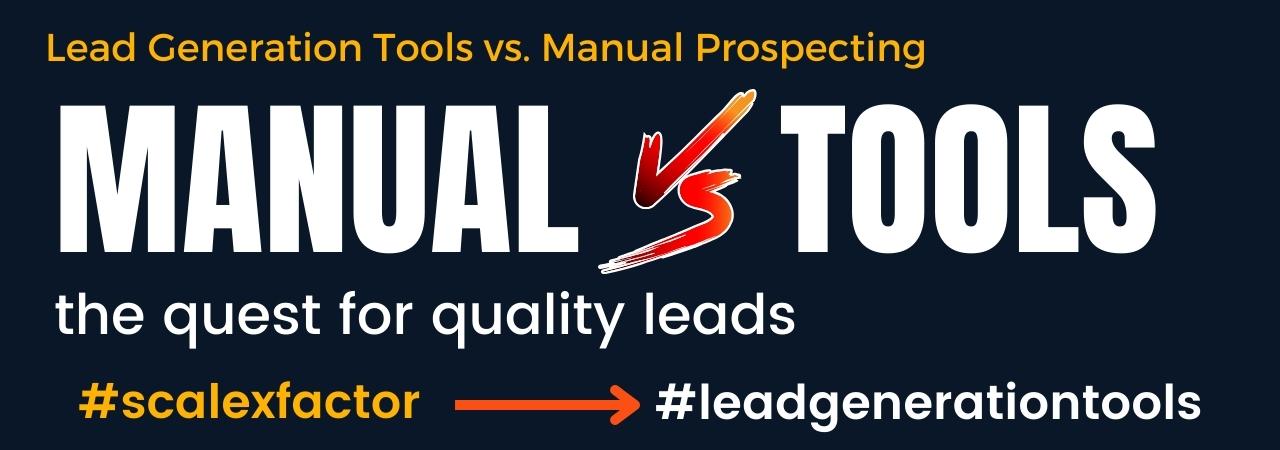In the ever-evolving landscape of business, the quest for quality leads is a constant endeavor. The age-old debate between Lead Generation Tools and Manual Prospecting continues to be a focal point for businesses seeking to expand their customer base and revenue streams.

In this comprehensive analysis, we’ll delve deep into the nuances of both approaches, shedding light on their advantages, disadvantages, and ultimate efficacy.
The Power of Automation: Lead Generation Tools
1. Streamlining Efficiency
Lead Generation Tools, in the digital age, have become indispensable. These automated software solutions can efficiently identify, categorize, and nurture leads, minimizing the time and effort required by manual prospecting. By automating repetitive tasks such as data collection and follow-ups, businesses can redirect their resources towards strategic endeavors.
2. Data-Driven Insights
One of the undeniable strengths of Lead Generation Tools is their ability to provide businesses with valuable data-driven insights. These tools can analyze vast datasets to identify patterns, preferences, and trends among potential customers. This data can then be harnessed to tailor marketing strategies, resulting in higher conversion rates and increased revenue.
3. Scalability
As businesses grow, so does the demand for leads. Manual prospecting can be limiting in this regard, as it relies heavily on human resources and can be time-consuming. Lead Generation Tools, on the other hand, offer scalability. They can handle a large volume of leads with ease, making them an ideal choice for businesses with ambitious growth targets.
4. Precision Targeting
The modern consumer expects personalized interactions. Lead Generation Tools excel in this area by allowing businesses to target specific demographics with precision. With advanced algorithms and machine learning, these tools can segment leads based on various criteria, ensuring that marketing efforts are highly relevant to the intended audience.
The Human Touch: Manual Prospecting
1. Building Authentic Relationships
Manual prospecting revolves around human interaction and relationship-building. This personal touch can create a strong bond between the salesperson and the prospect. Trust and rapport often develop more naturally in a manual prospecting scenario, potentially leading to long-term customer loyalty.
2. Adaptable Problem Solving
In complex B2B sales, where nuances and intricacies abound, manual prospecting shines. Skilled sales professionals can adapt their approach on the fly, addressing unique challenges and objections effectively. This adaptability is a valuable asset in industries where one-size-fits-all solutions don’t apply.
3. Immediate Feedback
Manual prospecting allows for real-time feedback. Salespeople can gauge the prospect’s reactions, objections, and concerns during conversations. This immediate feedback loop enables them to adjust their approach and tailor their pitch, increasing the chances of a successful conversion.
4. Niche Markets
For businesses operating in niche markets, manual prospecting may be the preferred method. These markets often require a deep understanding of specialized needs and a personal touch that automated tools may struggle to provide. Sales representatives who specialize in such niches can excel here.
Striking a Balance
The question of whether Lead Generation Tools or Manual Prospecting is superior is not a binary one. In reality, the best approach often involves a strategic blend of both methodologies.
1. Hybrid Approach
Many successful businesses adopt a hybrid approach, leveraging the efficiency and scalability of Lead Generation Tools while also valuing the human touch of manual prospecting. By striking this balance, they can capitalize on the strengths of both methods.
2. Data-Driven Manual Prospecting
Manual prospecting can also benefit from data-driven insights obtained through Lead Generation Tools. Sales professionals armed with valuable customer data can make more informed decisions and tailor their outreach more effectively.
3. Constant Adaptation
In a rapidly changing business landscape, flexibility is key. Businesses should be open to adjusting their lead generation strategies based on performance metrics and market dynamics. This adaptability ensures that they remain competitive and continue to grow.
Conclusion
In the eternal debate of Lead Generation Tools vs. Manual Prospecting, there is no one-size-fits-all answer. Each approach brings its own set of advantages and challenges to the table.
For businesses, the path to success lies in understanding their unique needs, target audience, and industry dynamics. By harnessing the strengths of both Lead Generation Tools and Manual Prospecting, they can create a lead generation strategy that is finely tuned to achieve their goals.
In the end, it’s not about choosing one over the other, but about finding the perfect synergy between automation and the human touch. The true winner is the business that can strike this balance most effectively, adapting and evolving as the business landscape continues to change. Lead Generation Tools and Manual Prospecting: it’s not a battle, but a symphony, where the harmony of both approaches leads to success.




